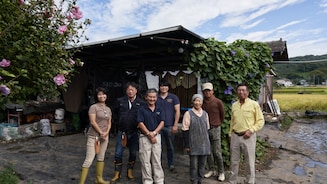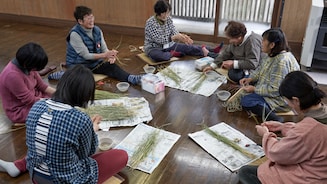Mishima Basketry
Deep in snow country, where the Tadami River ows, lies a town where handmade basketry is just one secret behind a community-wide joie de vivre.
•Amikumi-zaiku, which uses natural materials found locally, goes back to the Jomon Period (14,000 to 300 BC) and remains a part of everyday life even now.
•Ceremonies related to farming, peculiar to mountain villages, are still miraculously carried on by local residents.
•The beauty of nature’s four seasons and the wisdom accrued by people living in mountain villages and coexisting with nature.
Gunma Silk
A bioactive protein secreted by silkworms and typically discarded in silk-making is being recovered and adapted for use in high-end bath products that bene t skin and the environment.
• Washcloths and soaps made with sericin, highly e ective in skincare
• Environmental commitment: no formalin used in silk reeling
• Support of local sericulture farms through original product development
Seto Ceramicware
Kilns were ring wares in this Land of Pottery as far back as the 10th century. Seto potters today can meet just about any design or technical challenge. Read on to see their diverse styles.
• Setomono, or Seto ware, is synonymous with ceramics in Japan. The in uence of this “Land of Pottery” surpasses that of all other pottery producing areas in the country
• Clay, tools, diverse technical know-how, and educational facilities: everything to do with the ceramics trade is found in Seto
• Eight Seto potteries are open to the public. Tour them to see the quality rsthand
Kishu Lacquerware
The moist, silky look of urushi lacquer is deceiving: this all-natural coating is durable enough to outlast us all. Two artisans carry on the Kishu heritage of using raw sap in innovative ways.
• Plant-derived lacquer depletes no fossil materials and uses no harmful organic solvents
• Exclusive trading rights in the late 1700s propelled the area into an innovative center of lacquerware production, as Kishu products became accessible throughout Japan
• Our focus here is on certied traditional artisans* who use only natural materials
Sekishu Washi Paper
Crafted by hand from the ber of trees grown by the artisans themselves, these resilient, textured papers are easy on the environment in ways worth knowing about.
•Washi is truly sustainable as this paper made from a 1 year old tree can last 1000 years
•Processing the washi in various ways gives it a range of rich expression that inspires creators
• The bark of the paper mulberry that forms the base gives the washi its robustness and texture
Kurashiki Canvas
From ship sails to street fashions, Japan’s 100 percent natural high-quality canvas turns up in more places than you’d imagine. And it’s surprisingly soft and silky to the touch.
• Seventy percent of the canvas produced in Japan is made in Kurashiki
• A high-density weave yields the luxury look and ne quality of made-in-Japan canvas
• The extra-thick No. 2 canvas and the No. 8—the preferred choice of bag makers—are woven on vintage shuttle looms





